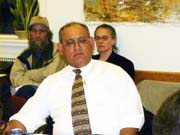Controversy erupted at Wednesday’s City Council meeting over whether or not to change the name of a street or simply add a secondary name.
Traditionally, cities find ways to honor people by naming streets after them. Martin Luther King Drive, John F. Kennedy Boulevard, and Luis Munoz Marin Boulevard not only honor an individual, but often represent a certain part of an ethnically diverse community.
In this vein, Gregory Malave, an employee of the Department of Housing, Economic Development and Commerce, has been actively lobbying to name a street after Juan Pablo Duarte, the founding father of the Dominican Republic. With the support of the administration, an ordinance on the City Council agenda would have done just that, renaming a portion Johnston Avenue from Grand Avenue to Audrey Zapp Drive after the esteemed liberator of the Dominican Republic from Haitian rule.
Malave has arranged for the president of the Dominican Republic to visit in June to celebrate the unveiling of the new street sign.
But many members of the City Council recall how an ordinance that attempted to change a portion of Pacific Avenue to Juan Pablo Duarte Drive in 1995 was vehemently protested by civilians who did not want to have to change their address.
So when June Jones, a vocal community activist, approached the City Council to question the ordinance, most council people immediately agreed with her argument. The council made a motion to amend the ordinance so that the street would have a secondary name, rather than completely renaming it. The amendment passed in a 7-2 vote, with the two Latino Councilmen, E. Junior Maldonado and Mariano Vega, dissenting.
The incident in 1995 began a routine of honoring people in such a fashion by adding a secondary name to the street. For instance, the corner of Zabriskie Street and Kennedy Boulevard has a sign that reads “also known as Frank Scalfani Corner.” The cross streets of Central Avenue and Congress Street is also known as Thomas Maresca Plaza, after a former Ward D councilman.
Malave said that the committee supporting the newly named street is content with the “also known as” title for the time being. But he hopes that it will eventually change, adding that the affected blocks are occupied predominantly by Dominican residents and businesses.
Vega said that the Jersey City is an international city, and it would behoove the city to honor an international hero. He compared Duarte to Luis Munoz Marin, the first governor of Puerto Rico.
“I don’t see my colleagues changing their minds on this one,” Ward D Councilman William Gaughan said. He charged that the people adamant about changing the name are thinking less about the community and more about politics.
Preserving the past
Yvonne Balcer, a Jersey City resident, warned the City Council against changing the names of streets because it detracts, she said, from the city’s historical roots. She cited past examples of the city erasing its history in an attempt to honor somebody that has no connection to the city.
For example, Martin Luther King Drive replaced Jackson Avenue. Many people were unaware that Jackson Avenue had been named for an African-American family that lived in Jersey City at the turn of the century and had become successful merchants.
“The Jackson family must be very unique to have a street named after them at a time of accepted racism,” Balcer said.
Similarly, Luis Munoz Marin Boulevard replaced Henderson Street, named after a former mayor of Jersey City. Gaughan asked if anyone at the council meeting was aware of the origin of Johnston Avenue, but no one responded.
